Projections suggest that by 2025, retail e-commerce sales in Canada are expected to soar to an impressive US$40.3 billion. These figures reflect the expanding landscape of digital commerce in Canada and underscore the increasing relevance of e-commerce in the retail industry.
Given this rapid growth, the significance of effective e-commerce returns management becomes more prominent. As sales volumes rise, so will the volume and value of returns, posing operational and logistical challenges for businesses.
Efficiently managing these returns is essential for maintaining customer satisfaction, ensuring cost-effectiveness, and sustaining the growth trajectory of the e-commerce sector.
Understanding the reasons behind returns, adopting strategies to minimize their occurrence, and efficiently processing returned items are key components of a successful returns management process.
In this blog, we will focus on strategies for efficient fulfillment in e-commerce returns management and explore the best practices and innovative methods essential for success in e-commerce returns management, aiming to help businesses enhance their operations and customer satisfaction in the online retail sector.
What is E-commerce Returns Management?
E-commerce returns management, a key component of the supply chain, involves managing the return of goods from customers to retailers. This aspect, integral to reverse logistics, focuses on efficiently processing returns and deploying strategies to minimize their occurrence.
The core objective of a robust returns management strategy is to streamline the returns process in a cost-effective way that benefits both the business and the customer.
The Strategic Benefits of E-commerce Returns Management
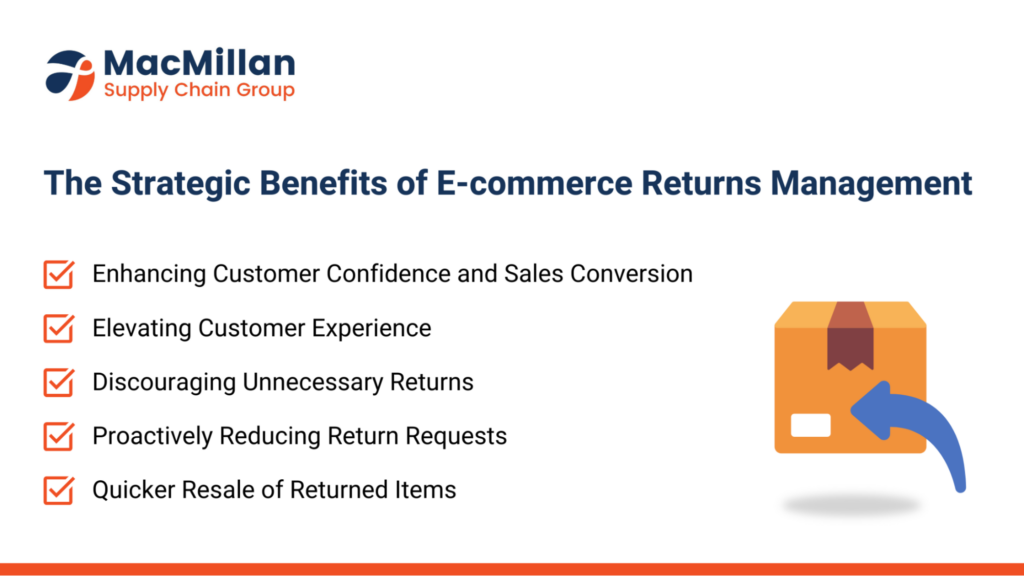
- Enhancing Customer Confidence and Sales Conversion
A clear and straightforward returns policy can greatly reduce potential customers’ reluctance before making a purchase. This approach builds trust and credibility, resulting in higher customer satisfaction.
Knowing that they can effortlessly return an unsatisfactory product, customers are more likely to complete a purchase, thereby boosting sales conversions.
- Elevating Customer Experience
The efficiency of the returns process is a critical factor in shaping a customer’s overall experience with a company. Delays in refunds or unclear return procedures can discourage future purchases.
Conversely, a streamlined and prompt returns process can enhance customer satisfaction, potentially leading to repeat business.
- Discouraging Unnecessary Returns
A well-defined returns policy helps in distinguishing between valid and invalid return requests. For instance, setting a specific timeframe for returns or conditions regarding the item’s usage can mitigate inappropriate returns.
This is particularly relevant in cases like ‘wardrobing,’ where customers purchase items to return them post-use. A stringent policy can effectively reduce such practices.
- Proactively Reducing Return Requests
An essential part of e-commerce returns management is prevention – minimizing the likelihood of returns. This can be achieved through various methods, such as providing comprehensive product information to aid customer decision-making and ensuring proper packaging to avoid damage during shipping.
- Quicker Resale of Returned Items
Efficient e-commerce returns management ensures that returned items are processed and available for resale. Prolonged processing times can result in delayed refunds and lost sales opportunities.
An effective strategy minimizes operational stress and enhances the business’s profitability by reducing the time items spend off the shelf.
A well-framed e-commerce returns management strategy is crucial for handling returns and building customer trust, improving shopping experience, preventing unnecessary returns, and maintaining a steady flow of merchandise for resale.
What are the Financial Implications of Returns in your E-Commerce Business?
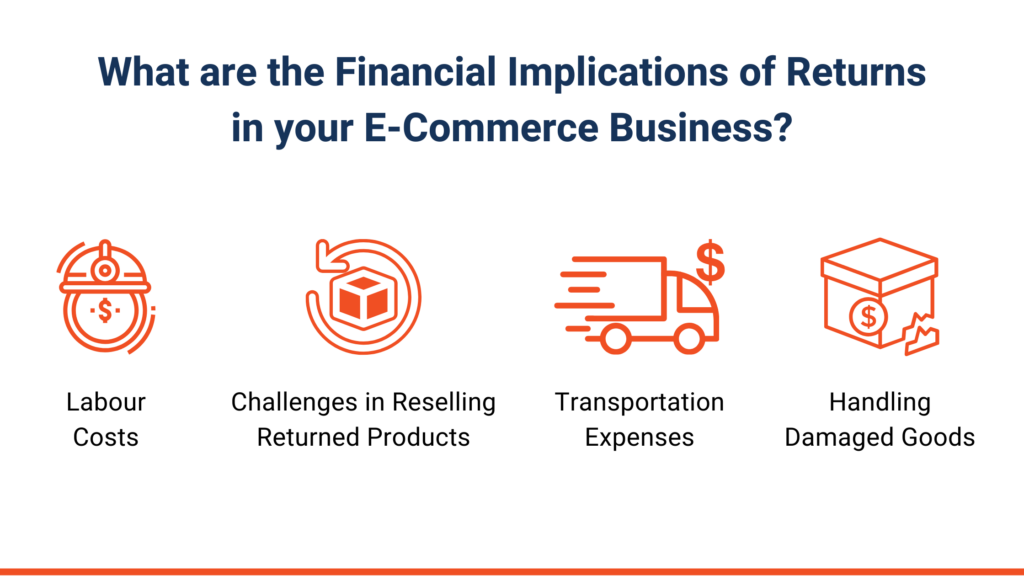
By implementing a transparent and straightforward returns policy, businesses can reduce customer hesitancy and streamline the returns process. This approach in e-commerce returns management fosters trust and credibility, increasing customer satisfaction.
Additionally, a well-managed returns system can provide valuable insights into product performance and customer preferences, aiding in inventory optimization and reducing the frequency of returns.
Let’s delve deeper into how e-commerce returns management impacts the various aspects of online retail operations, from customer experience to financial health.
- Labour Costs
Every return involves additional manpower to process and restock items. This includes handling the physical return, inspecting the product, and updating inventory systems. The need for extra labour to manage returns substantially burdens the workforce, impacting cost and efficiency.
- Challenges in Reselling Returned Products
Reselling returned items often requires repackaging and reintroducing them into the sales cycle, which is time-consuming and labour-intensive. Repackaging and restocking can decrease its perceived value and marketability even if the product is in good condition.
- Transportation Expenses
The cost of transporting returned items from customers back to the warehouse or store adds up, considering the expenses related to fuel, vehicle maintenance, and logistics management. Beyond the financial aspect, the transportation of returns also contributes to the environmental footprint of e-commerce operations.
- Handling Damaged Goods
Products returned in a damaged state represent a direct financial loss. If repairable, the cost of refurbishing can sometimes outweigh the benefits. Managing the lifecycle of products, from sale to return and potential disposal, is a complex and cost-intensive aspect of e-commerce.
Returns in e-commerce bring challenges that extend beyond simple customer satisfaction. They encompass labour, logistics, and product management, all contributing to online retail operations’ overall cost and efficiency.
Strategies to Maximize Efficiency in E-Commerce Returns Management
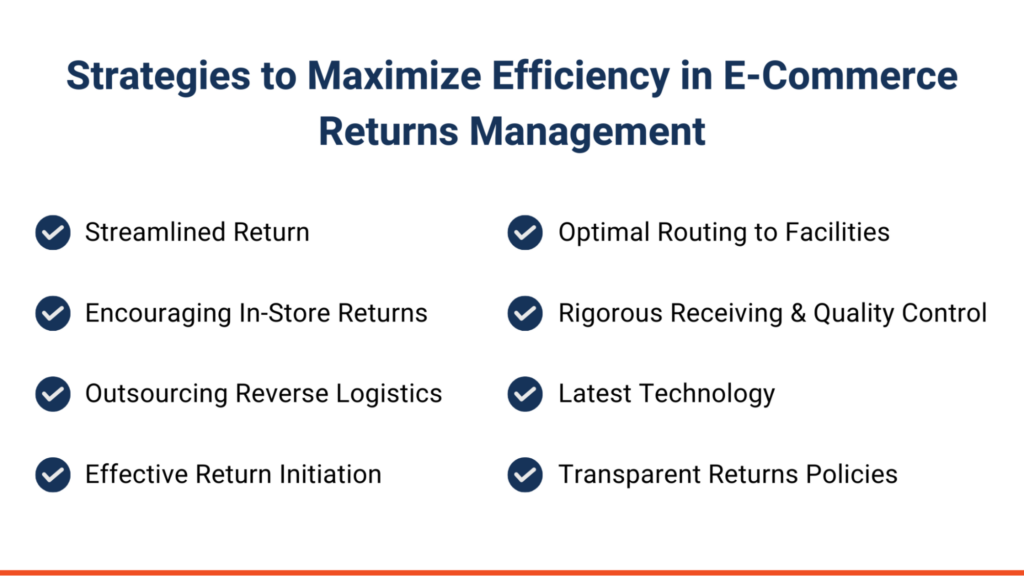
Here, we explore various strategies to streamline the returns process, making it a seamless experience for customers and retailers.
- Streamlined Return
When customers initiate a return for an online purchase, the product typically returns to the retailer’s warehouse or fulfillment center. The integration of e-commerce returns management software streamlines this entire process.
This technology plays a pivotal role in automating various tasks, such as providing real-time updates to customers about the status of their returns.
Additionally, it ensures that the inventory systems are updated instantly as returns are processed, thereby maintaining accurate stock levels and facilitating efficient inventory management.
- Encouraging In-Store Returns
Studies show that 62% of customers prefer online shopping when they can return products to a physical store. In-store returns allow for immediate product inspection and restocking. They also allow customers to exchange items instantly, potentially reducing future return requests.
- Outsourcing Reverse Logistics
Delegating the returns management process to specialized third-party logistics (3PL) providers, such as Macmillan, can markedly alleviate the operational load on retailers. These 3PL partners are adept at overseeing the entire spectrum of the returns journey.
This includes conducting detailed inspections of returned items to determine their condition and suitability for restocking.
This aspect of the process is vital as it ensures that only quality, saleable goods re-enter the supply chain. Following the inspection phase, these providers efficiently manage restocking suitable items.
Additionally, by outsourcing returns management, retailers can focus more on their core business functions without being encumbered by the logistical complexities of handling returns.
- Effective Return Initiation
Utilizing return services offered by e-commerce carriers can greatly simplify the return process for customers, making it more streamlined and user-friendly. On the other hand, allowing customers to initiate returns themselves can also be an economical choice for businesses.
However, it’s crucial to ensure that clear guidelines are provided to customers to facilitate a smooth and efficient return process.
- Optimal Routing to Facilities
Directing returned merchandise to the closest warehouse or retail location can lead to significant cost savings and enhance the efficiency of inventory distribution for e-commerce businesses.
The decision on which route to take for each return should be carefully considered based on factors such as the associated costs, the overall efficiency of the process, and the current demand for inventory at each location.
By optimizing the return routes in this manner, businesses can not only cut down on logistics expenses but also ensure a faster restocking process, ultimately improving the availability of products for future sales.
- Rigorous Receiving and Quality Control
Businesses must have a dedicated team in place for managing returned items. This team’s responsibility involves thoroughly assessing each returned product to determine its current state.
Based on this evaluation, they then make informed decisions about the next steps, whether restocking the item for resale, disposing of it if it’s unsalable, or sending it back to the vendor in cases of defects or warranty issues.
This process is critical to returns management, ensuring that decisions regarding the product’s future align with the company’s quality standards and operational efficiency.
- Latest Technology
Employ AI-driven analytics to automate inventory updates and optimize return routes. Utilize technology to understand customer preferences and reduce return rates through tailored product recommendations.
Additionally, using technology to analyze customer behavior and preferences enables a more personalized shopping experience.
This approach not only helps curate more targeted product recommendations but can also play a crucial role in reducing the rate of returns, as customers are more likely to be satisfied with their purchases when they align closely with their preferences and needs.
- Transparent Returns Policies
Display the return policy across various sections of your website to build trust and inform customers. Integrating the return policy on product pages, FAQs, and checkout can significantly influence purchase decisions.
This strategic placement ensures that customers have easy access to return information, helping them to feel more confident and secure in their buying choices.
Providing hassle-free returns with prepaid labels and multiple drop-off or pick-up options enhances customer loyalty. While costly, free return shipping is essential to meet customer expectations and remain competitive.
Efficient returns management is a multi-faceted process that requires a careful blend of customer-centric strategies, technological integration, and sustainable practices. By adopting these strategies, e-commerce businesses can turn the challenge of returns into an opportunity for enhancing customer satisfaction and operational efficiency.
How Does a 3PL Provider Enhance Reverse Logistics Efficiency?
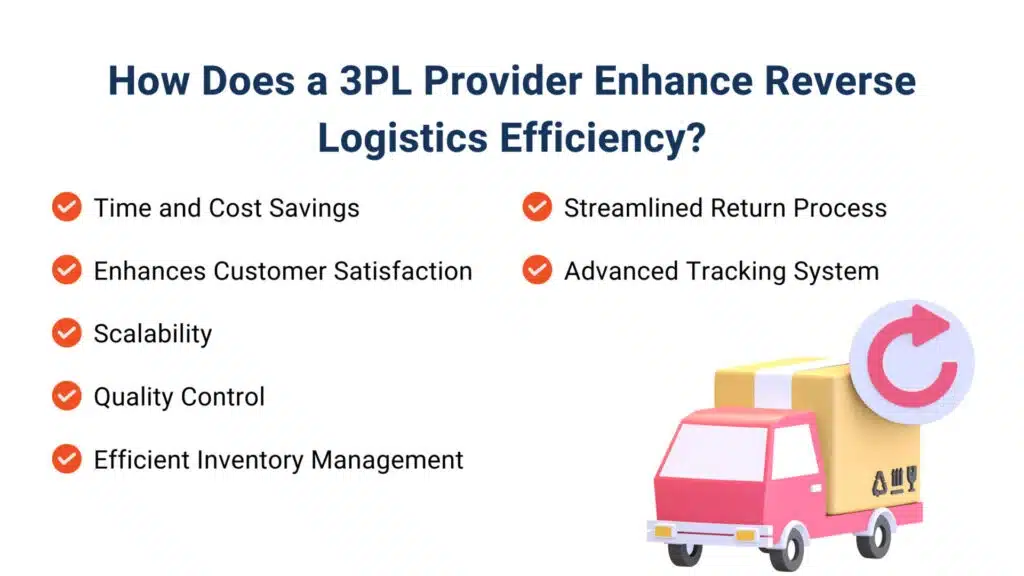
- Time and Cost Savings: A 3PL provider handles returns, exchanges, and product disposal, saving you time and reducing costs associated with these processes.
- Enhances Customer Satisfaction: Quick and easy returns encourage customers to shop again, improving their overall experience.
- Scalability: A 3PL adapts to your business needs. Whether you need more storage space or fewer resources, a 3PL can adjust accordingly, effectively helping you manage business fluctuations.
- Quality Control: 3PLs manage the inspection of returned items. They decide whether to discard, recycle, or restock items based on your store’s guidelines, ensuring quality control.
- Efficient Inventory Management: 3PLs take care of inventory tasks like cycle counts, labeling, and reporting, allowing you to focus on other business aspects.
- Streamlined Return Process: Having a network of warehouses, a 3PL enables faster processing of returns across various locations, enhancing customer satisfaction and repeat business.
- Advanced Tracking System: A 3PL comes with a sophisticated tracking system. This system helps monitor the returns process and gives you a clear picture of inventory status.
Using a 3PL for reverse logistics in e-commerce is a smart strategy. With a 3PL like Macmillan, you can handle returns efficiently and focus on growing your business.
Upgrade Your Reverse Logistics with MacMillan’s Expertise
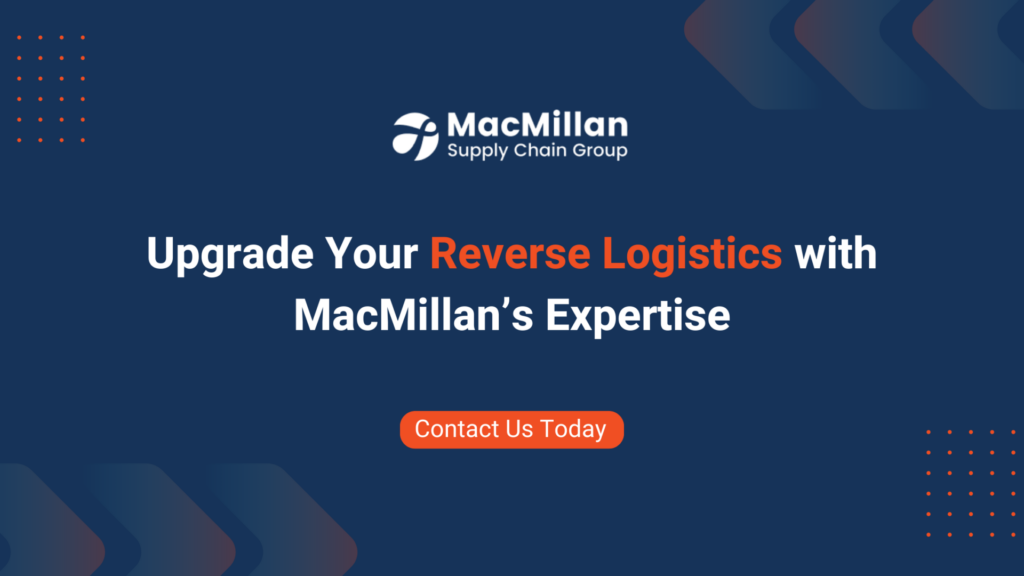
At MacMillan, we deal with extensive supply chain management and sophisticated reverse logistics capabilities. Our expert handling of your products, from the moment they arrive until they reach your customer, is designed to boost customer trust and satisfaction.
We recognize that every e-commerce venture is unique. That’s why we provide tailor-made solutions crafted to meet your market’s specific demands and dynamics. Our commitment to sustainability and building trust has helped us create a robust network, making MacMillan a reliable ally in the e-commerce sector.
Explore MacMillan’s E-commerce Fulfillment Services and let us be the driving force behind your thriving e-commerce strategy.




